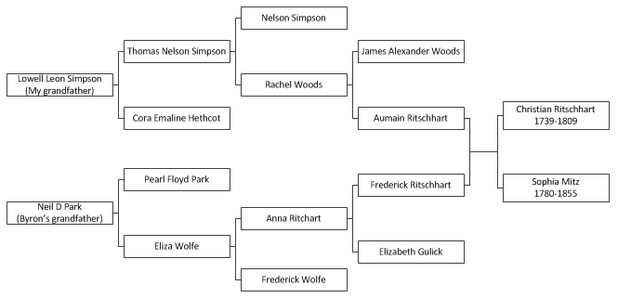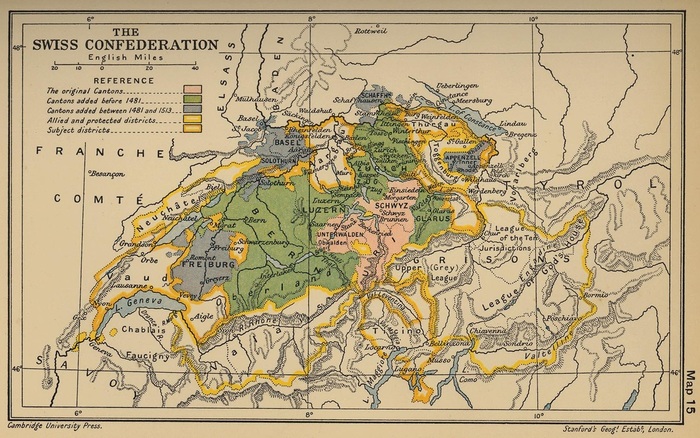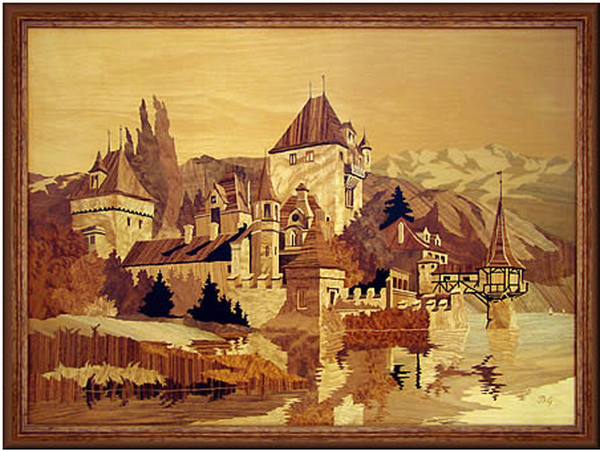|
Genetic genealogy has matched me with another 5th cousin, Byron, from Ohio. We are both descended from Christian Ritschhart (1738-1809) and his second, much younger, wife, Sophia Mitz (1780-1855). It's always nice to confirm the paper trail through DNA, however this is yet another one of those important branches to me. The Ritschharts are the longest branch in my family tree, thanks to the efforts of Bettye Anderson Ritchhart. In the early 1990s, Bettye flew to Switzerland and, with the help of professional genealogists and family, traced back the family tree to 1503 and recorded many interesting details, such as the family relationship with Oberhofen Castle. It's good to know that my connection to the Ritschharts is a real one. My earliest known ancestor is my 11th great grandfather, Melchior Ritschard, born 1503 in Hilterfingen, a small village of three hundred people, on the shores of Lake Thun (Thunersee), nestled within the highlands next to the Swiss Alps. Over the previous two centuries, Bern had gained control over the five valleys of the Bernese Oberland through purchase and conquest. Bern had also entered into a web of treaties with neighboring cities and cantons to form the Swiss Confederation (Alte Eidenossenschaft) In 1527, 24 year old Melchior married Margarethe, a 20 year old woman from his village. Melchior and Margarethe were born Catholic and likely married under the auspices of the Catholic Church. Not being noble, Melchior and Margarethe probably chose each other, rather than their families arranging their marriage for political or inheritance purposes. After the couple agreed to marry, the family would have made formal arrangements regarding dowry and inheritance, culminating in a engagement ceremony, where contracts were signed. Following the ceremony, the family registered the marriage with the civil authorities and posted notices of the marriage on the church doors for three days. During this period, anyone could file an objection to the marriage. Medieval Swiss weddings were often rowdy affairs. The day began with the bride and groom partaking in “morning soup” at the home of bride, which often left them both tipsy. They then strolled to the church, followed by family, friends, and well-wishers, to exchange vows in front of the doors. In the middle ages, blue was the colour of purity so they may have both worn a blue sash or ribbon. After the vows, the single men of the village might affably rough up the groom before the two newlyweds followed a flower-strewn path back to the bride’s family home, where they would spend the night and consummate the marriage. The next day would be filled with rowdy celebrations and drinking. While Melchior and Margarethe likely had several children, I so far only know of one: a boy born in 1539, whom they also named Melchior. This was a tumultuous period in the Swiss Confederation. The Protestant Reformation sparked uprisings in most cantons and even set cantons at war with each other. Bern secularized the church in 1528, taking control of monasteries and schools. This sparked an uprising across the Bernese Oberland, which lasted for several years. This was also the age of witch trials in the Swiss Confederation, which started in the mid-fifteenth century and lasted more than two hundred years. Tens-of-thousands of people were put on trial, often by ordeal, with as many as five thousand people (three-quarters were women) burned, beheaded, drowned, and hanged. Despite the many wars that enflamed Europe at this time and the religious upheaval, the Swiss Confederation was considered a bastion of stability. The Swiss army was very effective and Swiss mercenaries were highly valued and employed across Europe. In addition to the difficulty, the major nations knew that the conquest of the Swiss Confederation would not be tolerated by other larger powers and any attempt would cascade into a larger conflict. There is no evidence that our ancestors fell victim to war or faced trial for witchcraft, but these events would have loomed large in their lives. In 1560, Melchior II married Anna Staeli in Hilterfingen. Anna was the same age as Melchior, born in 1539. Three years later, in 1563, Anna gave birth to their son, Melchior III. Melchior was christened the day after Christmas, on December 26, 1563. Like his family for generations, Melchior lived his whole life in Hilterfingen, marrying Barbara Rupp (b. 1571) on February 13, 1592. Together they had several children, the youngest of whom was Michel (b.1605). Very close to Hilterfingen, on the shores of Lake Thun, was Oberhofen Castle (Schloss Oberhofen am Thunersee). Built in the 13th century, Oberhofen Castle had had many owners. The Hapsburg dynasty owned the castle in the 14th century but, after they were driven out of the Bernese Oberland, the castle fell under the control of the Scharnachthals, a powerful Bern dynasty. In 1590, the last Scharnachthal, Niklaus III, died without issue and the castle passed to his nephews, the von Erlach family.
This transition was beneficial for the Ritschards, as the von Erlachs raised Melchior to the position of bailiff for Oberhofen Castle. Traditionally, bailiffs were outsiders to region so this appointment was unusual. As bailiff, Melchior served as the von Erlach’s representative and would have overseen the lands and buildings of the castle, collected rents and kept the books. At least 3 Ritschards served as castle bailiff: Melchior (mentioned above), Melcher b. 1584, and Michel (1605-1658), my 8th great grandfather. It was during a period of state ownership of Oberhoffen that Michel (b. 1605) was recorded by the Bern archives as being “Klosterammann”, a Cloister Bailiff. In 1652 the state took over the castle and used it as a seat for its District governor until 1798. It was then that a French invasion put an end to the Republic of Bern and the entire Alte Eidenossenschaft. My ancestor Ritschards continued to live in the village of Oberhoffen until 1750, when Christian Ritschhart (1709-1790), the great-grandson of Michel and my 5th great grandfather, took his family, including his son, my 4th great grandfather, Christian (1739-1809), and left Switzerland on a perilous journey to America, on which he lost his fortune but survived to spread the family name to a whole new continent. Comments are closed.
|
Archives
2023 JAN FEB MAR APR MAY JUN JUL AUG SEP 2022 JAN FEB MAR APR MAY JUN JUL AUG SEP OCT NOV DEC 2021 JAN FEB MAR APR MAY JUN JUL AUG SEP OCT NOV DEC 2020 JAN FEB MAR APR MAY JUN JUL AUG SEP OCT NOV DEC 2019 JAN FEB MAR APR MAY JUN JUL AUG SEP OCT NOV DEC 2018 JAN FEB MAR APR MAY JUN JUL AUG SEP OCT NOV DEC 2017 JAN FEB MAR APR MAY JUN JUL AUG SEP OCT NOV DEC 2016 JAN FEB MAR APR MAY JUN JUL AUG SEP OCT NOV DEC 2015 JAN FEB MAR APR MAY JUN JUL AUG SEP OCT NOV DEC 2014 OCT NOV DEC Categories |



 RSS Feed
RSS Feed